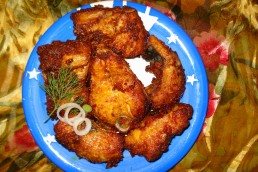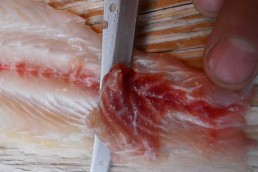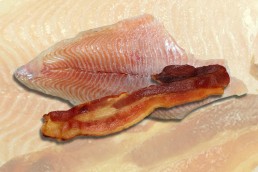Chicken-fried Fish: What’s Chicken Got to Do with It?
SHARE THIS POST
I was recently looking at copycat recipes for a chicken company’s famous “secret herbs and spices” and came across one of the ingredients, Tellicherry pepper. When researching further online, one blogger mentioned: “Tellicherry peppercorns and regular black pepper both come from the same vine (and so do green and white peppercorns, but that’s another subject for another blog post). All are (from) the species called Piper nigrum.”
He went on to add that at the end of the growing season in India—February and March—the pepper fruit is picked from the vine. The pepper is then dried over a series of days and eventually shrivels and turns into what we know as black peppercorns. All of these peppercorns are then shipped to “garbling” facilities where they sort the peppercorns by size and bag them. The sorting machines have several different large flat metal screens with thousands of identical holes in them. The machines shake the peppercorns so that the smaller ones fall through the screens with the smallest falling to the very bottom screen. Once sorted, the various peppercorn sizes are distinguished from each other and labeled and sold for different prices.
He added that a Tellicherry peppercorn is actually determined by size. So when a black peppercorn is a 4 1/2-mm pinhead or larger, it’s a “Tellicherry.” That’s all there is to it. And because the Tellicherry is so much larger than the other peppercorns, these then make up a much smaller percentage of the total crop. Oftentimes, they’ll represent 10 percent or less of any given harvest. There are fewer of them too, so they command a higher price at market.
Now that we know what a Tellicherry peppercorn is, how do we use it? Easy—just like black pepper. After researching, the described taste and aroma is “sharp, strong, mild heat, robust and complex.” It’s used as an all-purpose pepper for the kitchen and considered by many to be the finest pepper in the world. And, it’s only grown on Mount Tellicherry in Kerala, India.
Secret Copycat Spices Recipe
1 tablespoon paprika
2 teaspoons onion salt
1 teaspoon chili powder
1 teaspoon Tellicherry (or use black or white pepper)
1/2 teaspoon celery salt
1/2 teaspoon dried sage
1/2 teaspoon garlic powder
1/2 teaspoon ground allspice
1/2 teaspoon dried oregano
1/2 teaspoon dried basil
1/2 teaspoon dried marjoram
Mix spices thoroughly. Blend can then be mixed with flour. This combination can be found in the Chicken-fried Fish recipe, as the mixture tastes terrific on most fish.
TIP: Run this blend through a grinder to make a fine powder and store in an airtight glass jar. I’ll use it to replace spices in other recipes. Make triple or quadruple the recipe mixture to store for long periods, but keep in mind spices can expire and become rancid.
Chicken-fried Fish
2 to 3 fillets (per person)
Are you enjoying this post?
You can be among the first to get the latest info on where to go, what to use and how to use it!
Spices mixture from above (use all of the recipe)
1 1/2 cups all-purpose flour
1 tablespoon brown sugar
1 tablespoon kosher salt
1 egg white
Canola oil for frying
Lightly coat fillets in egg whites. Cover with blended spice mixture. Repeat a few times, making sure the flour mix sticks well to the fish. Let fillets rest for 5 minutes so crust dries a bit to ensure a crisper chicken-fried fish. Fry at 365 degrees until golden brown.
TIP: Make notes in your cookbook of ingredients and/or techniques that you employed to enhance your recipes and your efficiency. Also, note mistakes so as not to make them again.
Having fun with P.E.T.A. cookbook
I received a tongue-in-cheek cookbook, People Eating Tasty Animals by Robert Arlen. The recipes in P.E.T.A. are for a wide variety of critters, some endangered. Arlen must have had a lot of fun concocting this book. He says he hasn’t tested all the recipes out and adds that some are very good while others are awful—hence the entertainment value. And if you do try a recipe, Arlen says, “Let me know how it tastes and if you died when you ate it.”
He explains you can—I say you should—change most of the recipes by substituting meats that are easily and legally acquired such as beef for bear or giraffe, and chicken for bats or parakeets, and so on. I’m not sure which meat would take the place of cats or dogs, but there’s no doubt you’ll prefer BBQ pork ribs instead of “Bengal Tiger Ribs,” even if you could shoot one.
He often includes clever hints: For “Japanese Seal Stew,” Arlen recommends tenderizing the meat by clubbing it on both sides. For “Rhino Pot Pie,” he recommends: “Rhino is very filling and a meal by itself. Serve with a light beer.”
This may be a tongue-in-cheek recipe for termites, but it’s plentiful in the South, and sounds tasty.
Fried termites
3 cups termites
2 tablespoons vegetable oil
Salt, pepper
Garlic to taste
Canola oil
Pull off and discard the wings. Add salt, pepper and garlic to termites. Heat oil in a pan. Add termites. Cook until crisp. Takes very little time to cook.
Arlen suggests that you place P.E.T.A. on your coffee table for dinner guests to see. They’ll compliment you and be thrilled to have had such exotic fare. His cookbook can be found online.
MWO
SHARE THIS POST
Did you enjoy this post?
You can be among the first to get the latest info on where to go, what to use and how to use it!
Vernon Summerlin
For more than 30 years, Vernon Summerlin has produced outdoor articles and books that can be found on Amazon; most recently How to Analyze a Bass Hole: Think and Catch’em! He is the recipient of more than 40 awards for magazine and newspaper articles, TV, radio, photography and books.



